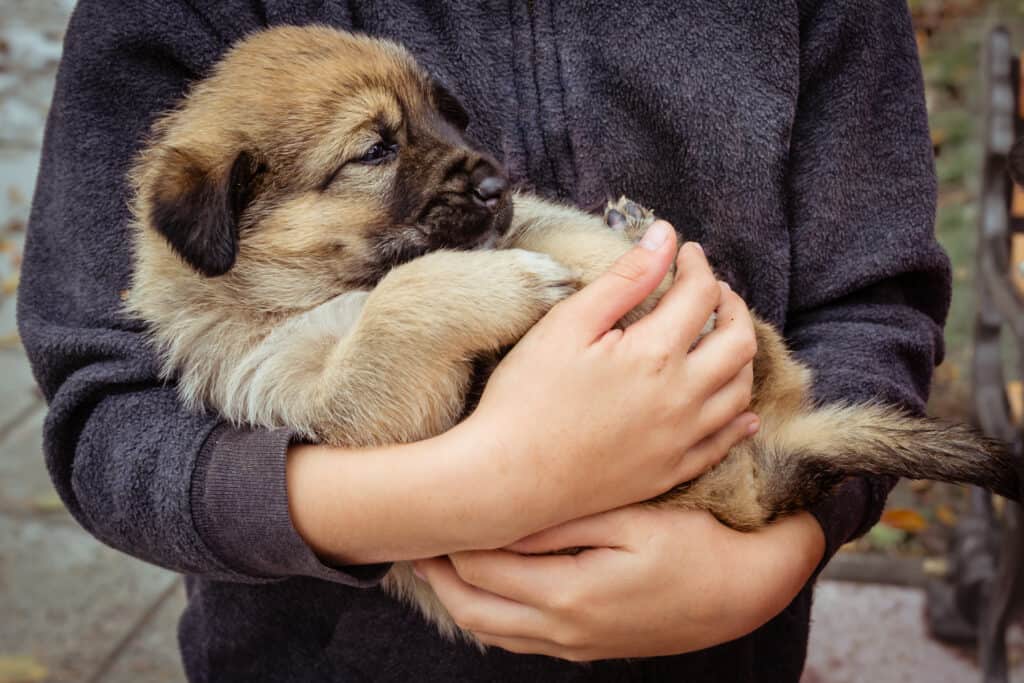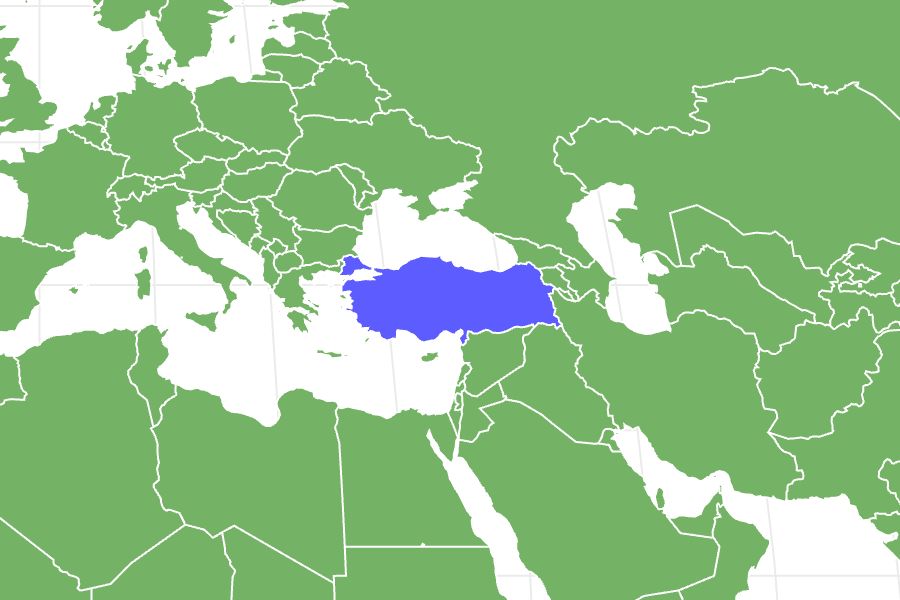Sarplaninac
Canis lupus
Advertisement
Sarplaninac Scientific Classification
- Kingdom
- Animalia
- Phylum
- Chordata
- Class
- Mammalia
- Order
- Carnivora
- Family
- Canidae
- Genus
- Canis
- Scientific Name
- Canis lupus
Read our Complete Guide to Classification of Animals.
Sarplaninac Conservation Status
Sarplaninac Facts
Sarplaninac as a Pet:
- General Health
- Energy Level
- Shedability
- Trainability
- Intelligence
- Tendency to Chew
- Size
- Family and kid friendliness
- Yappiness / Barking
- Low
- Separation Anxiety
- Low
- Preferred Temperature
- Cold climate
- Exercise Needs
- High
- Friendly With Other Dogs
- High
- Pure bred cost to own
- $1500
- Dog group
- Herding
- Male weight
- 75-100 lbs
- Female weight
- 65-88 lbs
View all of the Sarplaninac images!
“According to some sources, the Sarplaninac (pronounced Shar-pla-nee-natz) had ten name changes before gaining its current name.”
Summary
Sarplaninac dogs are an ancient herd-guarding breed originating in the southeastern mountains of Yugoslavia, known thousands of years ago as Illyria. Breeders first called the dogs Illyrian shepherd dogs until 1957, when they received their current name, which references the Sharplanina mountain range.
The breeding lines of the Sarplaninac are uncertain due to how long they’ve been around. Experts believe they descended from ancient Grecian and Turkey dogs that worked alongside farmers, protecting their animals from predators such as wolves.
Until 1970, Sarplaninacs could not legally leave Yugoslavia. The very first dog that arrived in the U.S. had to be carried down from the Sharplanina mountains by mule. Since the breed arrived in the States, a growing body of ranchers has successfully employed Sarplaninacs to protect their flocks, just as farmers did in their home country. These medium-sized dogs with great strength, supreme intelligence, and devotion to their families make excellent partners and companions if trained with solid leadership.
Read on to learn more about Sarplaninac dogs and what to know before adding one to your family.
The Best Dog Food for Sarplaninac
Sarplaninacs should eat high-quality dog food that provides balanced nutrition and the right mix of vitamins, protein, and healthy fats, whether it’s dry food or vet-approved human food recipes. You should also consider your dog’s diet based on age, as puppies, adults, and seniors all require different formulations to match their current life stages.
While Sarplaninacs enjoy people food as treats, we recommend keeping the amount to 10 percent of their diet. Instead, aim to provide a high-protein formula that supports muscle growth, promotes healthy joints and bones, and keeps coats and skin healthy.
A formula like Blue Buffalo’s Wilderness Rocky Mountain Recipe High Protein contains real beef and animal-sourced protein ingredients to help your dog develop appropriate muscle mass and support its high energy. The blend also contains the following:
- Antioxidants
- Healthy supplements such as glucosamine and chondroitin for joint health
- Plenty of omega 3 and 6 fatty acids for skin health
In addition to food, make sure to provide clean, potable water to your Sarplaninac at all times. Treats are helpful as positive reinforcement during training, but don’t give out too much, or your pup can start to gain weight.
3 Pros and Cons of Owning a Sarplaninac
| Pros! | Cons! |
|---|---|
| Highly intelligent and easily trainable These smart dogs will learn your commands and new tricks in no time. | Independent Lacking proper training, your dog may not respect your leadership and decide to do what it thinks is best. |
| Exceedingly loyal Sarplaninac are ever loyal to their families. | Wary of strangers Dogs may feel the need to protect their families from newcomers. |
| Healthy with low medical maintenance Sarplaninac have no common health issues. | High-maintenance grooming needs These dogs shed their double-coats year-round and require weekly brushing. |
Sarplaninac Size and Weight
At full maturity, Sarplaninac females average about 22.5 inches from the withers, while males stretch slightly taller at 24 inches. Full-grown females weigh between 65 to 88 pounds, while males weigh as much as 100 pounds.
| Sex | Size |
|---|---|
| Male | 24’ Tall, 100lbs, fully grown |
| Female | 22.5’ Tall, 88lbs, fully grown |
Sarplaninac Common Health Issues
While Sarplaninac dogs are generally healthy, diligent breeders will test their parent dogs for commonly inheritable genetic conditions. Sarplaninac can be susceptible to hip and elbow dysplasia, similar to other medium-sized, high-activity dogs. While you should confirm whether a pup is likely to inherit this before purchasing, proper nutrition and joint-health supplements can help prevent the condition.
Sarplaninac also have a propensity to bloat, so be careful only to feed your dog a well-balanced diet crafted with high-quality, nutritious ingredients. Watch food intake, too, to mitigate obesity or weight issues.
Sarplaninac Temperament
As sheep-guarding dogs, Sarplaninac are mild-mannered but exhibit a general wariness towards strangers, ever watchful of their “flock.” They form close bonds with their family and sometimes physically stand between strangers and their loved ones to protect them from danger. Despite their protective instincts, Sarplaninac are neither aggressive nor violent, requiring high levels of provocation to make them react.
These dogs are brilliant and loyal and will respect their masters as leaders of the pack once they’ve earned it.
How To Take Care of Sarplaninac
Your Sarplaninac requires moderate levels of grooming, but he will come to love these rituals if motivated with proper treats and positive experiences. They ask for more dedication to training and regular exercise than the average pup. But if regularly stimulated and adequately socialized, your Sarplaninac will be a loyal protector for life.
Maintenance and Grooming
These dogs developed thick double coats to protect them from Yugoslavia’s cold mountain winters. They moderately shed, requiring regular brushing and the occasional bath to keep their coats in top shape and prevent hair from getting everywhere. Make sure to trim their nails regularly if they don’t naturally grind down, as too-long nails can make walking uncomfortable and lead to hip or elbow issues. Periodically check for dirt or debris in the ears, and routine teeth-brushing is a must.
Training
Sarplaninacs are highly intelligent dogs, thanks to their working purpose, and generally are a breeze to train. However, sometimes they will think they know better than their owners, given their strong independence. A determined and consistent training routine will establish you as the pack leader, and your sarplaninac will be happy to follow commands.
Exercise
The Sarplaninac thrives in wide open spaces, used to roaming the mountainsides with their flocks. As such, they’re usually unhappy being confined to apartments, much preferring to run in a vast open space. They require plentiful outdoor exercise, whether walking for about an hour daily or running around in a fenced yard or dog park. Mental stimulation is also necessary to prevent your Sarplaninac from becoming anxious and potentially destructive.
Puppies
New Sarplaninac puppies require a watchful eye, consistent, dedicated training, and plenty of socialization. Keep them busy with new tricks, potty training, and eventual puppy school, so they can learn proper doggy manners and get acquainted with strangers. This breed is naturally wary of new people and dogs – early socialization will go a long way toward getting them used to new encounters.

Sarplaninac puppies like to keep busy with new tricks, potty training, and school.
©HASphotos/Shutterstock.com
Sarplaninac and Children
This breed is very loving to children, especially if they are raised alongside the kids in their family. As protectors, they are watchful guardians of their flocks and will alert their masters to any danger. Sarplaninac are just as happy protecting other animals in the family and generally get along well with other dogs if raised together.
Dogs Similar to Sarplaninac
The Sarplaninac is closely related to other herd-guarding breeds, such as the Moscow watchdog, Maremma sheepdog, and Akbash.
- Moscow watchdog: These mild-mannered dogs are watchful, protective guardians of livestock.
- Maremma sheepdog: Maremmas also were bred to guard their herds against predators.
- Akbash: The Akbash is another ancient breed of dog, originally bred in Turkey.
Popular Names for Sarplaninac
Popular names for Sarplaninac dogs include:
- Buddy
- Toby
- Tucker
- Bella
- Ellie
- Abigail
Up Next
View all 293 animals that start with SSarplaninac FAQs (Frequently Asked Questions)
Are Sarplaninac good pets?
Sarplaninac make excellent family pets for those who can provide them with lots of exercise or a job that keeps them busy. These intelligent creatures are highly independent and require more socialization and regular training than the average pup.
Does Sarplaninac shed?
These dogs are medium-level shedders with long double coats that require weekly brushing with the occasional bath to keep them clean.
What does a Sarplaninac dog look like?
The dog is medium-to-large sized with big heads. Thick, coarse coats keep them warm in the wintertime.
Thank you for reading! Have some feedback for us? Contact the AZ Animals editorial team.
Sources
- FEDERATION CYNOLOGIQUE INTERNATIONALE, Available here: http://www.fci.be/Nomenclature/Standards/041g02-en.pdf
- United Kennel Club, Available here: https://www.ukcdogs.com/sarplaninac
- Danish Veterinary and Food Administration, Available here: https://www.foedevarestyrelsen.dk/english/ImportExport/Travelling_with_pet_animals/Pages/The-Danish-dog-legislation.aspx
















